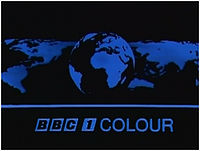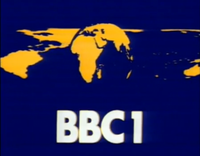- NODD (Nexus Orthicon Display Device)
-
NODD (pronounced "noddy"), which stands for Nexus Orthicon Display Device[1] , was the method used for generating identifications for the BBC1 and BBC2 television networks from 1963[2] to February 1985.
Contents
About NODD
The term NODD can be used to mean a variety of different things. The actual definition of the NODD system is the process of filming an image in black and white and electronically adding colour before the image itself is aired. The term NODD, or NODD (Noddy) Room can also be used to describe the location where the idents, clocks and other presentation devices are arranged atop and beside each other in front of a black and white camera that can be remotely operated to be pointing at a number of idents.[1][3] The system was designed by BBC designer Murray Andrew.[4]
The BBC first employed the system in 1969 when the introduced the new mirror globe ident for BBC1, and the introduction of colour to this service. The system was easy to use, as the remote operating allowed the announcer to control it him/herself with ease, and allowed the idents to be of no fixed length so the globe or clock symbols could continue for many minutes at a time. It was also easy to change the colours used to make something such as a rebrand easy to perform.[1][3]
The BBC1 Mirrored Globe
The most famous use of the NODD system was the BBC1 mirrored globes used between 1969 and 1985, albeit with minor colour changes. The globe model featured an internally lit globe, with the sea being painted on in metallic black paint, and the land masses being clear, in front of a concave mirror.[1] The original mirror globe ident was introduced on 15 November 1969 and featured blue continents and legend against a black background.[4][3] The legend included the word 'Colour' after the BBC1 corporate logo, both to indicate the new format the programme were being broadcast in, but also to act as a subtle reminder to the vast majority of viewers, still watching in black and white, to buy a colour TV set and the much more expensive colour television licence which financed the BBC.[4][3] The colours of blue and black were chosen because they are still easily distinguishable to those with a black and white set, as the vast majority of the population still did not own a colour set.[4][3] The ident was modified in 1972 to include the new, rounder BBC logo, which also resulted in the 'Colour' legend appearing in an italic serif font.[4][3] There was also another version of the globe that didn't contain a 'Colour' legend which was used before schools programmes, which were filmed in black and white until 1972.[5]
In 1974, the globe was altered again: the colours were changed to yellow continents with a dark blue background. The legend was changed to simply BBC1, this time in Futura typeface, and the 'Colour' identification was removed.[1][3] This version lasted until 1981, when it was again changed, the colours changed to a green globe with dark blue background, with a double striped BBC1 legend. Throughout all these years, the globe model itself was altered as it had to be frequently re-painted and modified. This led to a number of odd variations: the tip of South Africa was pointed in some 1981 variations, and the pacific islands more pronounced in other models.[6][3]
Alongside the mirrored globe, a number of other presentational devices were used. The main one of these being the clock. The clock also used the NODD system, allowing the colours to be the same as the present ident. To allow enough light onto the model, a light was fixed onto the camera to shine onto the clock and other idents; this light was not used on the main ident however. The clock was mechanical and featured numerals of double lines that increased in thickness the further round the clockface. The clock also featured a 'polo' mint centre. This clock is quite distinguishable and is most recognizable with the BBC. The clocks colour and legend never differed from that of the main ident.[1][4][3]
The clock was changed in December 1981, with the introduction of a computerized clock. Following BBC2's rebrand to the electronic striped 2 ident, technicians started working on an electronic clock to accompany the new look, and following its completion it was this that replaced mechanical version. The new clock featured a single uniform line thickness all the way round, except at 12, 3, 6 and 9 where the lines were doubled. The polo mint centre was also removed in favour of a central dot.[6][3]
The looks were also accompanied by static programme captions. The captions for the 1969 to 1974 look used the legend of the ident in their captions located at the bottom of the screen.[7] However, the style was changed in c.1974 to feature a banner at the top of the image featuring double striped lines and the double striped BBC1 logo. This design was used from c.1974 until 1985.[8]
Replacement
The mirrored globe was retired at 7pm on 18 February 1985, with the first showing of the globe's replacement: the Computer Originated World or COW for short. The globe was retired because of the fact it was the only live mechanical model used on television and the maintenance required was making it difficult to use; even the 1981 rebrand caused a number of difficulties such as bad positioning, odd colours and other errors. The globe was also becoming old fashioned, due to it's service since the invention of colour.[3][9]
The NODD system went with the globe, as all idents and clocks were now electronically generated, and as a result the equipment wasn't needed. Cameras were still for programme slides until the late 1980s, when the programme slides became electronically generated also.[10]
Trivia
- Contrary to the belief of many, NODD was not called so because the camera could nod in any direction at the push of a button.[1]
- The mechanical clock that accompanied the look gained so much status that the design was included on the BBC website when it was redesigned in 2007, and features on the homepage to this day.
- The 1972 Mechanical Globe ident was recreated to introduce the second series of Life on Mars.
References
- ^ a b c d e f g Luxton, Simon. "1974 Idents". TVARK. http://www2.tv-ark.org.uk/bbcone/1974_idents.html. Retrieved 19 September 2011. Contains videos of the yellow NODD globe, as well as a detailed account of how the system went including behind the scenes pictures.
- ^ Kempton, Martin. "BBC Television Centre". History of Television Studios in London. TV Studio History. http://www.tvstudiohistory.co.uk/tv%20centre%20history.htm#pres. Retrieved 19 September 2011. A detailed account of the history of BBC Television Centre including a brief look at Presentation and the NODD system.
- ^ a b c d e f g h i j k Wiseman, Andrew. "BBC Logo Gallery". 625: Andrew Wiseman's Television Room. http://625.uk.com/tv_logos/bbc.htm. Retrieved 19 September 2011.Contains behind the scenes images and brief account of the NODD System and globes.
- ^ a b c d e f Luxton, Simon. "1969 Idents". TVARK. http://www2.tv-ark.org.uk/bbcone/1969_idents.html. Retrieved 19 September 2011. Contains videos of BBC idents from the time.
- ^ Jeffrey, Dave. "More Flash Files". 625: Andrew Wiseman's Television Room. http://625.uk.com/tv_logos/flash/bbc1_clock_schools_69.asp. Retrieved 19 September 2011. Contains a flash receation of the Black and White Schools ident, based on authentic recordings.
- ^ a b Luxton, Simon. "1981 Idents". TVARK. http://www2.tv-ark.org.uk/bbcone/1981_idents.html. Retrieved 19 September 2011. Contains videos and images of BBC1 Idents.
- ^ Luxton, Simon. "1969 Continuity". TVARK. http://www2.tv-ark.org.uk/bbcone/1969_continuity.html. Retrieved 19 September 2011. Conatains images and videos of BBC1 continuity.
- ^ Luxton, Simon. "1974 Continuity". TVARK. http://www2.tv-ark.org.uk/bbcone/1974_continuity.html. Retrieved 19 September 2011. Contains videos of BBC Continuity between 1974 and 1981.
- ^ Luxton, Simon. "1985 Idents". TVARK. http://www2.tv-ark.org.uk/bbcone/1985_idents.html. Retrieved 19 September 2011.
- ^ Luxton, Simon. "1985 Continuity". TVARK. http://www2.tv-ark.org.uk/bbcone/1985_continuity.html. Retrieved 19 September 2011.
External Links
Preceded by
BBC One Pre-1969 IdentsBBC television idents
November 15 1969–18 February 1985Succeeded by
BBC One 'COW Globe' identBBC Television BBC UK channels BBC One (in Northern Ireland • Scotland • Wales) · BBC Two (in Northern Ireland • Scotland • Wales) · BBC Three · BBC Four · BBC News · BBC Parliament · CBBC · CBeebies · BBC HD
Joint ventures and
international channelsBBC Alba · BBC America · BBC Arabic Television · BBC Canada · BBC Entertainment · BBC HD (International) · BBC Kids · BBC Knowledge (International) · BBC Lifestyle · BBC Persian Television · BBC World News · CBeebies (International) · Community Channel · UKTV (UK and Ireland) · UKTV (Australia and New Zealand)Services and Programming blocks UK Regions Scotland · Wales · Northern Ireland · North East and Cumbria · North West · Yorkshire · Yorkshire and Lincolnshire · West · Midlands · East Midlands · East · London · South West · South · South EastDefunct channels BBC Choice (in Northern Ireland) · BBC Food · BBC Japan · BBC Knowledge (UK) · BBC Prime · BBC Select · BBC TV Europe · BBC World Service Television · BBC 2W
 Category
CategoryBBC Television Idents BBC One Pre 1969 · NODD Globe · COW Globe · Virtual Globe · Balloon idents · Rhythm & Movement idents · Circle identsBBC Two Launch ident · Cube 2 · Striped 2 · Computer Generated 2 · TWO · The 1991 2's · Personality 2's · Window on the WorldCurrent Channels BBC Three Idents · BBC Four Idents · BBC News Channel Idents · BBC Parliament Idents · BBC World News Idents · CBBC Idents · CBeebies IdentsDefunct Channels Category · Portal Categories:- Television technology
Wikimedia Foundation. 2010.



